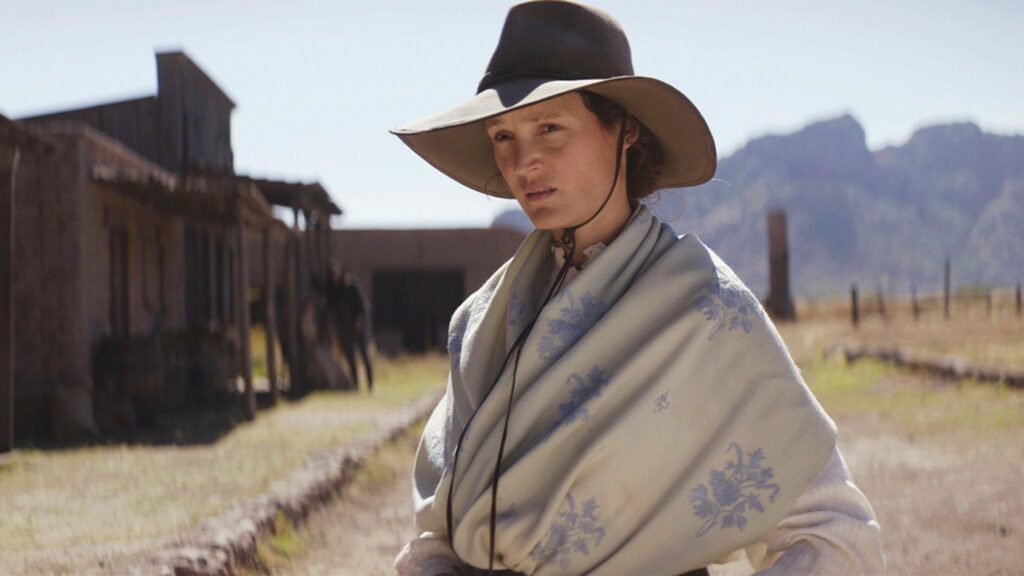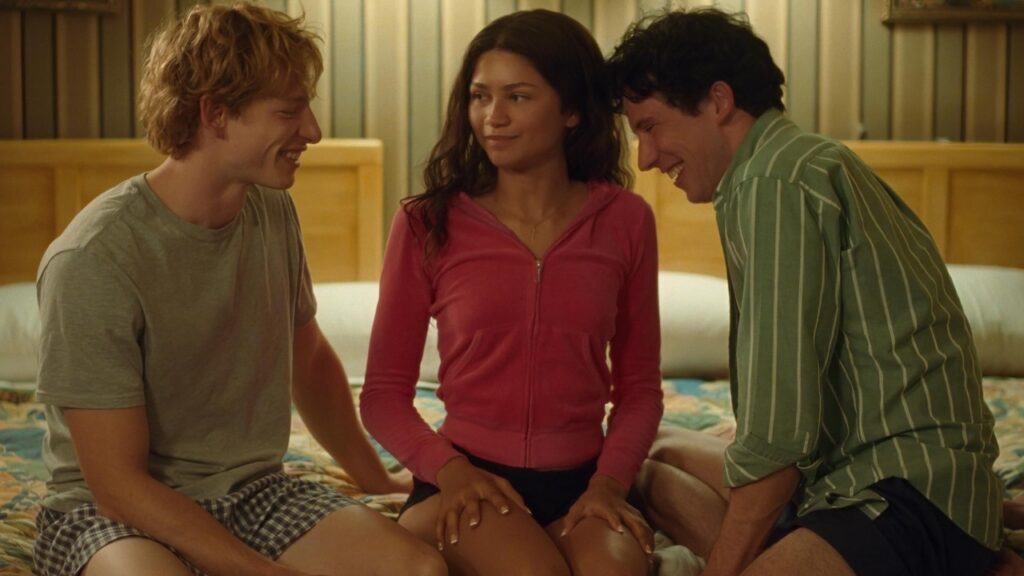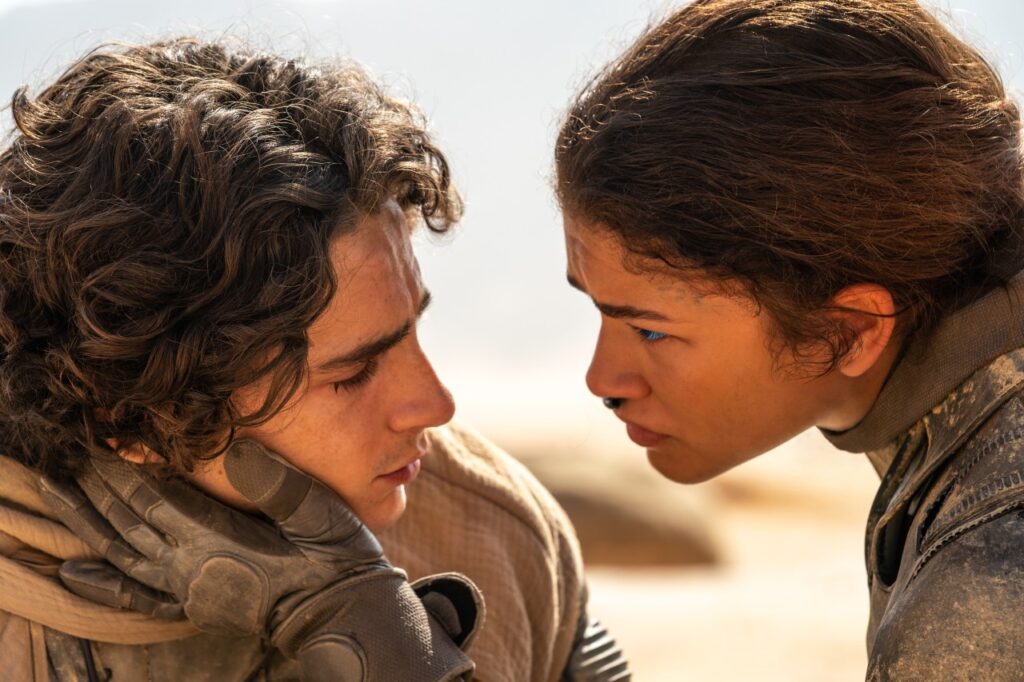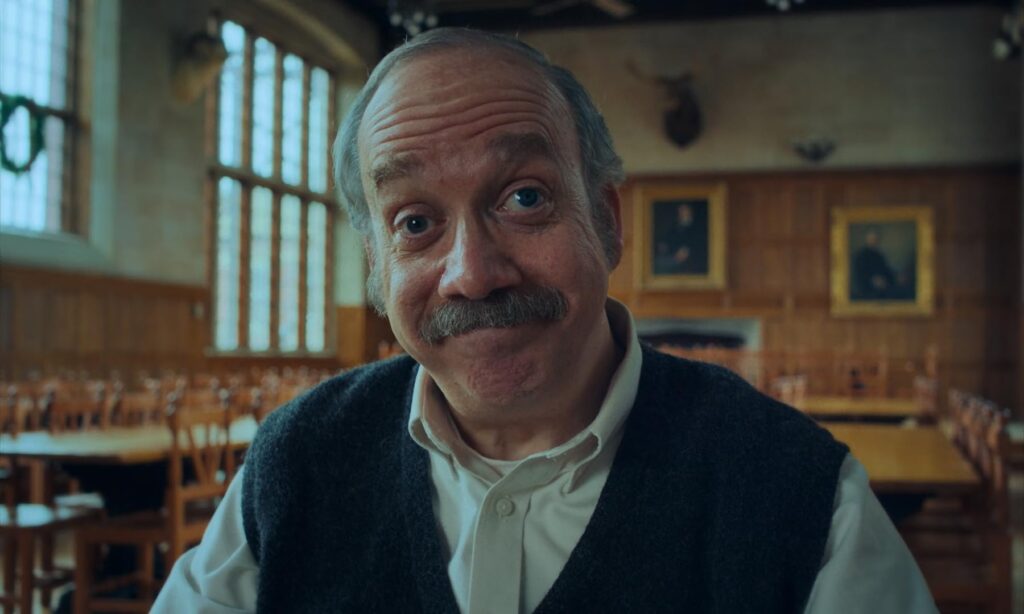Previous Articles in This Series
The 50 Best Films of 2024 in the UK: 50 – 41
The 50 Best Films of 2024 in the UK: 40 – 31
The 50 Best Films of 2024 in the UK: 30 – 21
The 50 Best Films of 2024 in the UK: 20 – 11
10 – Conclave
We’re down to the final 10 entries in our rundown of the 50 Best Films of 2024 in the UK. And coming in at #10 on our list is Conclave. Conclave is a mystery thriller directed Peter Straughan, and is an adaption of the 2016 novel of the same name. After the Pope dies of a heart attack, Cardinal-Dean Thomas Lawrence summons the leaders of the Catholic Church to Rome for the election of a new Pope. There are four leading candidates: the progressive Aldo Bellini of the United States, who wants to modernise the Church; Joshua Adeyemi of Nigeria, Joseph Tremblay of Canada, and Goffredo Tedesco of Italy. Cardinals Adeyemi, Trembley and Tedesco are all conservatives to varying degrees. The gathering of Cardinals, known as a Conclave, results in a series of political games as these four candidates try to outmanoeuvre each other for the Papacy.
Despite being set in the world of organized religion, Conclave feels like a modern twist on both the whodunnit and political thriller genres. The scheming and political-wrangling we see during the movie would feel right at home in any thriller novel, or an episode of Succession. Conclave also makes brilliant use of its ensemble cast. Ralph Fiennes is sensational as the pious Cardinal Lawrence, who is experiencing a crisis of faith. And Sergio Castelitto’s makes for a great moustache-twirling villain as the preening and vain Cardinal Tedesco. So if you’re looking for an enjoyable film to see at the cinema this Christmas, you could do a lot worse than take yourself down to your local see and watch Conclave.
9 – The Teacher’s Lounge
Continuing the trend of taut, tense thrillers making it into my top 10 films of the years, the next film on the list is The Teacher’s Lounge. Ilker Çatak’s latest film follows the life of German secondary school teacher Carla Nowak (Leonie Benesch). A relative newcomer to the school, Carla is an idealist and perhaps a bit naive. After one of Carla’s students is accused of committing a spate of thefts in the school, she sets about clearing his name. Her pursuit of justice causes Carla to acquire evidence through questionable methods, and shifts the finger of blame onto another member of staff. These actions eventually put her in conflict with another student – Oskar – who is the son of the disgraced faculty member.
The Teacher’s Lounge is arguably the most tense film of the year. The Teacher’s Lounge is largely shot with tight camera angles, focusing on the actor’s faces. This helps give the film a claustrophobic and tense feeling. On the few times director Ilker Çatak’ does allow the camera to pan out and show us more of the wider world, it is done to create a sense of confusion and bewilderment. This is most obvious in one scene with Carla is standing on a walkway, her eyes franticly looking down and surveying the busy school corridors for the school thief.
The Teacher’s Lounge also works brilliantly as a commentary on modern society. The film uses the setting of the classroom to touch upon a number of contemporary themes, including racial profiling and class. It does an excellent job of showing viewers how idealistic and well-intentioned actions, can sometimes have disastrous consequences.

8 – The Dead Don’t Hurt
The Dead Don’t Hurt is a western written, directed and produced by Lord of the Rings actor Viggo Mortensen. The film tells the story (albeit in a non-liner manner) of two immigrants – Danish carpenter Holger Olsen (Viggo Mortensen) and Vivienne Le Coudy (Vicky Krieps) in 1860s California. The couple settle in the town of Elk Flats, a small settlement ran by landowner Alfred Jeffries and his son Weston. Vivian decides to work in the local saloon as a barmaid to help occupy her time. Several years later, Olsen signs up to fight for the Union Army in the American Civil War. This creates an environment where Weston feels he has an opportunity to try and seduce Vivienne. Despite multiple spurned advances, events soon take a dark and violent turn.
The Dead Don’t Hurt is a breathtaking piece of cinema that brilliantly updates the genre for a modern audience. Viggo Mortensen (for the most part) abandons many of the lazy tropes associated with the western movie genre. Instead he decides to focus on letting viewers get an intimate and loving glimpse into Vivienne and Olsen’s relationship. Mortensen’s handling of their relationship is perfect: they clearly love one another deeply, and it is also a relationship of equals. This allows viewers to become deeply emotionally invested in Mortensen and Krieps’ onscreen relationship.
Yet this is also the Wild West we’re discussing: violence and death are a daily occurrence. So when events do take a tragic and deadly turn, Mortensen’s script has already laid the groundwork for what is a poignant and emotionally satisfying climax.
7 – The Outrun
The Outrun is a drama film starring the wonderful Saoirse Ronan. It is based on a screenplay co-written by Amy Liptrot, and draws inspiration from her 2016 memoir. Saoirse Ronan plays Rona, a young woman originally from the Orkney Islands who has recently been released from rehab. The Outrun tells the story of Rona’s struggles with alcohol addiction. This is done via a non-linear narrative
The Outrun is an incredible and challenging piece of cinema centred around a career-defining performance from Saoirse Ronan. In lesser hands, the film could have easily descended into unnecessary melodrama. But Nora Fingscheidt and Amy Liptrot’s screenplay avoids the tired cliches of depicting alcoholism. This is perhaps exemplified by one scene where Rona visits her father, who is experiencing a bipolar episode. Rona discovers him in a catatonic state. In a moment of weakness resulting from this stressful situation, she suffers a brief relapse by dipping her finger into his half-empty wine glass. Moments such as these give The Outrun an authenticity that few films can replicate, as they would be aiming to exploit this scene for dramatic effect.
The other aspect I loved about The Outrun was its use of Orkney’s harsh vitas. Yunus Roy Imer’s cinematography paints Orkney as a beautiful but tough place to live. The film regularly shows waves crashing tumultuously against the island’s shoreline. There are also several keys scenes that take place in the midst of violent storms. These violent mood swings in the climate of the island mirror Rona’s battle with alcoholism throughout the film. So in a sense the isle of Orkney can almost be considered a character in The Outrun.

6 – Challengers
Released in May of this year. Challengers was the standout film of the Spring/Summer period. Starring the trio of Zendaya, Mike Faist and Josh O’Connor, Challengers was a fun, sexy, and at times bonkers exploration of the world of competitive tennis. The movie follows follows two male tennis stars: Art Donaldson (Mike Faist) and Patrick Zweig (John O’Connor). Art and Patrick are a young up-and-coming doubles tennis duo, with a bright future. However, their friendship both on and off the court is tested when they meet tennis prodigy Tashi Duncan (Zendaya).
In an inspired creative decision mimicking a tennis match, Challengers jumps back-and-forth through time. These flashback show show us glimpses of the trio throughout their careers. They also give audiences a sense of the continually changing power dynamics between Art and Patrick, as they compete for Tashi’s affections.
Zendaya meanwhile gives a career-best performance as the confident Tashi Ducan. Tashi clearly gets a kick out from knowing she has power over both Patrick and Art. She is able to exploit their natural competitiveness over her to get them to perform both on and off the court. I
In the world of Challengers, success on the court is power; and so is sex. Challengers explores where these two worlds converge. And how these power dynamics can change as quickly as the momentum of tennis match.
While the drama that takes place during these flashback is incredibly entertaining, Challengers‘ tennis scenes equally as enthralling. Director Luca Guadagnino throws everything bar the kitchen sink at the scenes involving Art and Patrick’s climatic showdown. Cinematographer Sayomphu Mukdiphrom more than meets this challenge, shooting these exchanges from every conceivable angle possible. This includes the bizarre decision to film one rally from a first-person perspective view. Meanwhile Trent Reznor and Atticus Rose’s pulsing techno soundtrack will get audiences blood pumping during these scenes.
Challengers is a funny, sexy movie that is arguably the most fun one can have in the cinema this year. Sure it’s about as subtle as a sledgehammer. But Luca Guadagnino has put together a film so stylish and entertaining, it’s hard to resist its charms.
5 – The Zone of Interest
The winner of the Best International Picture at this year Oscars, The Zone of Interest is the latest film from director Jonathan Glazer. Loosely based on a 2014 novel, it depicts the life of Auschwitz commandant Rudolph Höss and his wife Hedwig.
The Zone of Interest is unquestionably the most important film of the past year. Unlike most other movies concerning the Holocaust, The Zone of Interest doesn’t take viewers inside the confines of the concentration camp. Nor do we ever see any of the prisoners in Auschwitz. Instead, we only get subtle hints at the appalling genocide taking place beyond the walls through the use of muffled screams following gunfire, or from plumes of smoke rising in the distance from Auscwitz’s incinerators.
This has led people to describe The Zone of Interest as a study of the “banality of evil.. And this is a perfect assessment of the film. Over the course of the move, we see the Höss family go about their daily routine. The family are desensitised to the terrible events occurring just beyond the walls of their garden. The only time we really get a glimpse of anyone reacting or acknowledging what is happening outside of the house is when Hedwig’s mother visits the family. Initially Hedwig’s mother is impressed by her daughter’s status. However, she is eventually forced to leave due to the stench of burning human flesh from Auschwitz’s incinerators.

4 – Dune: Part Two
Three years on from Dune: Part One, director Denis Villeneuve returned to the desert planet of Arrakis for the second part of his adaptation of Frank Herbert’s iconic novel ‘Dune’. Dune: Part Two picks top shortly after the events of its predecessor. The exiled Paul Atreides (Timothée Chalamet) and his mother Lady Jessica (Rebecca Ferguson) have taken refuge with Arrakis’ semi-nomadic Fremen tribe. Meanwhile the treacherous Harkonnen clan attempt to seize control of the desert planet’s spice production. Fremen attacks on the Harkonnen’s infrastructure thwart these attempts to secure the planet’s spice production.
Dune: Part Two also expanded upon the mythology and world-building of its predecessor by spending more time away from Arrakis. Viewers got to visit the Imperial homeward – Kaitan – where we received a glimpse of politicial machinations impacting the Imperium. And we also returned to the Harkonnen’s home planet of Giedi Prime. Here we discovered that the all-female Bene Gesserit religious cult ordered the murder of House Atreides in Dune: Part One. This power play was part of their plan to enact a prophecy that would lead to a holy war.
Dune: Part Two was unquestionably the biggest film of the year from a production standpoint. Director Denis Villeneuve where possible shunned Hollywood’s over-reliance on CGI in favour of practical effects, resulting in a more immersive cinematic experience. The action scenes in Dune: Part Two have a sense of scale that has been sadly lacking from modern Hollywood blockbusters since perhaps Peter Jackson’s Lord of the Rings trilogy.
3 – Poor Things
The second of two films on this list starring Emma Stone and directed by Yorgos Lanthimos. Set in a steampunk-inspired Victorian England, Poor Things tells the story of Bella Baxter (Emma Stone). When we first meet her, Bella is a prisoner in the townhouse of vivisectionist Dr. Godwin Baxter (Willem Dafoe). Despite having the body of an adult, Bella lives a childlike existence and shows a keen curiosity in the world. Dr. Baxter recruits of one of his students – Max McCandles (Ramy Youssef) – to study Bella’s development. Max’s arrival at the Baxter residence leads to Bella’s thirst for knowledge to accelerate at a rapid pace.
Max’s arrival also leads to Bella experiencing a sexual awakening, and her becoming increasingly frustrated by the imprisonment. Bella is eventually whisked away by the vain and caddish lawyer Duncan Wedderburn (Mark Ruffalo). Weddernburn and Bella embark on a globe-trotting adventure that sees them visit a variety of locals including Athens and Paris.
The first thing viewers of Poor Things would have noticed is the brilliant and physical performance Emma Stone gives throughout the movie. Her portrayal of the continually evolving Bella Baxter is arguably then single-best performance of the year, and was deserving of the Best Actress Oscar which Stone picked up in March. Stone brings a physicality to the role (particularly during the first two acts of Poor Things) that few actors could deliver. Whether it cartoonishly gliding across the dance floor of a Lisbon hotel like a wind-up toy, or just reacting to everyday conversation, Emma Stone gives her all to the role. And it is an absolute joy to behold.
Poor Things is also a film which is a marvel to behold from a production standpoint. Director Yorgos Lanthimos makes brilliant use of colour throughout Poor Things. The film transitions from a monochrome palette during Bella’s confinement in Dr. Baxter’s townhouse, to bright-oversaturated technicolour once she embarks on her globe-trotting adventure. Poor Things also features some incredible sets deigned by Shona Heath and James Price. These sets (which typically stand in for various European cities) have a strong steampunk aesthetic, and are reminiscent of diorama miniatures.
2 – Anora
The penultimate film on this year’s list is Anora. Feating a breakout performance from Mikey Maddison, Anora is the eighth film from writer and Director Sean Baker. The film follows the life of 23 year old lap dancer Anora “Ani” Mikheeva (Mikey Maddison). Ani lives in a Russian-American neighbourhood in Brooklyn, which is also run down. Early in the film she is introduced to Ivan “Vanya” Zakharov (Mark Eydelshteyn), the young son of a Russian oligarch. Vanya initially hires Ani for sexual encounters, offering her $15,000 to stay at his parent’s empty mansion for a week. During this period, Vanya suggests that he and Ani elope to Las Vegas and get marry so he can get a green card.
Vanya’s parents send their handler Toros (Karren Karagulia) to bring Vanya back to Russia, upending Ani’s seemingly perfect new life. Toros along with two henchmen – Garnick and Igor (Yura Borisov) – arrives at the Zakharov mansion. Vanya flees upon their arrival. After a tense and prolonged standoff, Ani reluctantly agrees to help Toros and his goon hunt down Vanya.
Anora is a wild, and at times dizzying film. Early in the film, one of the lap dancers at Anora’s workplace makes a reference to the fairytale Cinderella. And this seemingly throwaway line of dialogue is a deliberate choice by director Sean Baker, as Anora feels like a modern dissection of the traditional fairytale. Anora’s arrival at the Zakharov mansion early on, is the film’s equivalent of Cinderella (or Anora in this instance) trying on the glass slipper, and experiencing a glimpse of how the one percent live.
Sean Baker continues to toy with the Cinderella themes, with Darya Ekamasova making a late appearance as the wicked mother-in-law Galina Zakharov. He also dissects and tears apart the notion of the “Prince Charming” through the characters of Vanya and Igor. Vanya starts off as a sympathetic character, before it’s revealed he’s a spoiled child.
Yet describing Anora as merely a modern twist on the Cinderella-story would be doing it a gross disservice. Anora is a film that is as much about power dynamics, and the lies we tell ourselves to be able to perform the duties expected of us. Mikey Maddison performances as Ani gives us the best insights into these themes. At the start of Anora, Ani is portrayed as very much a streetwise hustler,who uses her sexuality as a form of soft power. However, once Ani marries Vanya, she quickly loses this agency as she is drawn further into the world of the billionaire class. We do eventually get a glimpse of the her more streetwise side in the latter stages of Anora. This occurs when Ani clashes with Galina, over the Zakharov’s demands for her to sign an annulment.
On the subject of whether Ani is performing the role of Vanya’s dutiful wife, I do believe that is the case. As they look for Vanya, Ani frequently professes her love for Vanya to Toros and his goons. On my first viewing of Anora, I took these professions on face value. However on my second viewing, I was more sceptical. I don’t mean that in the sense that I felt she was manipulating or exploiting Vanya. The two characters clearly enjoy each other’s company. Instead I felt these professions of love were Ani trying to convince herself she could feel romantic love for Vanya.

1 – The Holdovers
And so here we are: my pick for the best film of the year. 2024 has been a great year for movies albeit perhaps not as strong as 2023. Nonetheless, we’ve seen a draft of incredible films from a diverse range of genres and directors. Towards the end of the year, I had considered Anora as a possibility for my ‘Film of 2024’. But ultimately I felt compelled to pick the one film which has occupied the top spot virtually all year. And that film is Alexander Payne’s festive comedy-drama The Holdovers!
Set in December 1970, The Holdovers follows curmudgeon teacher Paul Hunman (Paul Giamatti). A teacher of classics at Barton Academy private school in New England, Paul is despised by faculty and students alike. Paul awards the son of a wealthy donor a grade that costs him a place at Princeton. As punishment, the headmaster assigns Paul the thankless task of looking after students who have to remain at Barton over Christmas. This punishment leads to Paul crossing paths with student Angus Tully (Dominic Sessa), and cafeteria worker Mary Lamb (Da’Vine Joy Randolph).
The Holdovers features three incredible performances from its ensemble cast. Dominic Sessa (making his acting debut here) is fantastic as the troubled and rebellious Angus Tully. Sessa and Giamatti trade some fantastic barbs throughout The Holdovers, and their exchanges provided much of the comedic relief in the film. Dominic Sessa also gets to showcase his abilities at more dramatic roles in the latter stages of The Holdovers.
Ja’Vine Joy Randolph meanwhile is equally brilliant, albeit somewhat under-utilised as cafeteria worker Ms. Lamb. Her performances here as a grieving mother was fully deserving of Best Supporting Actress at this year’s Academy Awards. It also provides a valuable insight into class/social dynamics of 1970s America, as young African-American men were unable to dodge the Vietnam War draft, unlike their white counterparts.
Of course the star of The Holdovers is unquestionably Paul Giamatti as teacher Paul Hunman. His turn as the grumpy and resentful Mr. Hunman is perfect. Paul starts the movie as an embittered and resentful figure. However in the true spirit of Christmas, Paul’s prickly demeanour slowly softens as he’s forced to spend time with both Angus and Ms. Lamb. Paul Giamatti’s brilliantly expressive face is perfect for the role, as you can easily tell what emotions the character is experiencing at any given time. And in the earlier stages of the film, Giamatti also gets to showcase his talent for slapstick comedy.
In conclusion, The Holdovers is a timeless piece of cinema. With its stellar ensemble cast, and near-perfect mix of comedy and drama, it is a film that everyone should see. And with its message that it’s never too late to change your ways, The Holdovers feels destined to become a modern Christmas classic!!!
